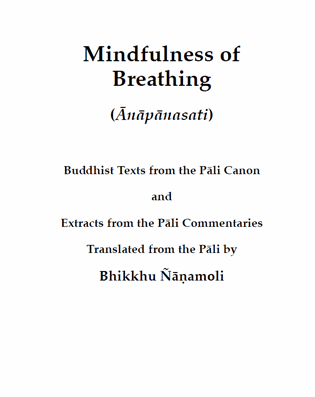
Mindfulness of Breathing - Trannslated by Bhikkhu Nanamoli
708 KB in PDF / Free Download / Click Here
This is a useful anthology of important and pragmatic source material from the Pali Canon and Commentaries on the technique of Anapana, or breath-awareness meditation. It includes the Discourse on Respiration-Mindfulness from the Majjhima Nikaya, commentary from the Vishuddhimagga (Path of Purification), and analyses of other passages and suttas.
Bhikkhu Ñanamoli was ordained as a monk in Sri Lanka, where he spent 11 years living in a monastery and translating the texts of the Theravada Buddhism into English. He was the author of The Discourse on Right View, Middle Length Discourses of the Buddha, and The Life of the Buddha.
'Mindfulnes of Breathing' / Amazon.com Reviews of the Retail Version:
The Real Anapanasati Suttra Explained / This review is from: Mindfulness of Breathing (Paperback)
The Anapanasati Suttra wordings alone do not make laymen understand instantly. On Theravada Buddhism Education, People should read other Suttras, inside Tipitaka (Pai Canon) ,which related to this Anapanasati Suttra too. Otherwise, You will end up with doubts and confusion.
Some Buddhists who explain this Suttra without refering to other, write with their own understanding which is very dangerous to follow. Bhikkhu Nanamoli does a great Job to refer everything related to this Suttra with other related Suttra. Thus, this book is highly recommended !!!. The most important things are - You have to practice and let it flow inside you as naturally as possible. Then 16 steps will appear as described in that Suttra. Step by Step.
Mindfulness of Breathing (Paperback)
Among many contemporary translations and commentaries on the Anapanasati Sutta (Majjhima Nikaya 118), this book stands out for including the fifth century commentary by Buddhaghosa as well as other references to anapanasati from the MN.
Although Ven. Nanamoli's style is wooden and his choice of words dated, even opaque as in calling the breath a "bodily formation", the commentary by Buddhaghosa (the Papancasudani) which is not found translated elsewhere in English is worth the price of the book.
For instance, Buddhaghosa explains that the the third step, translated as "experience the whole body" (sabba kaya), refers to the whole body of breath, not to the flesh-and-blood body as commonly translated. It may be useful to weigh these various interpretations to arrive at a reasoned conclusion.